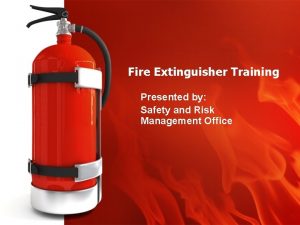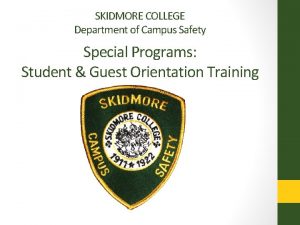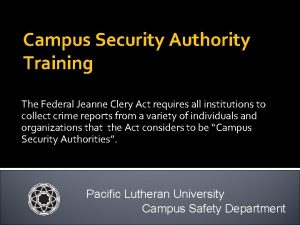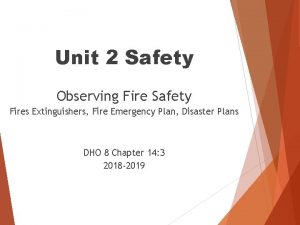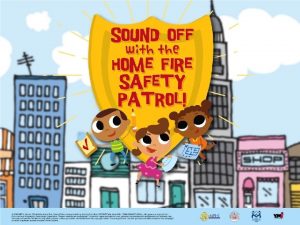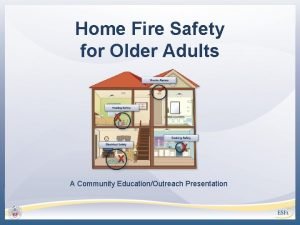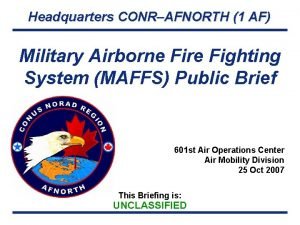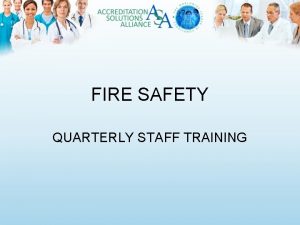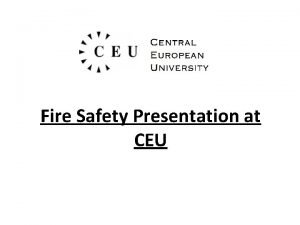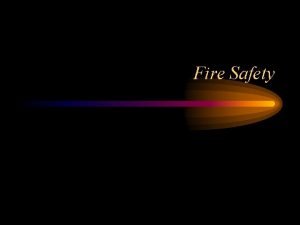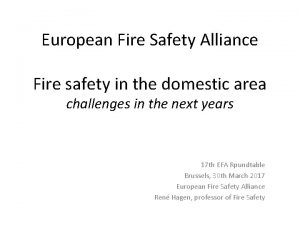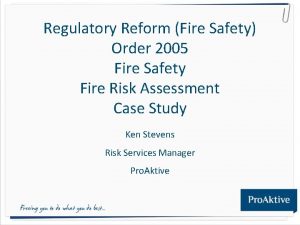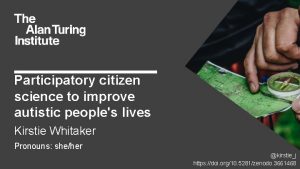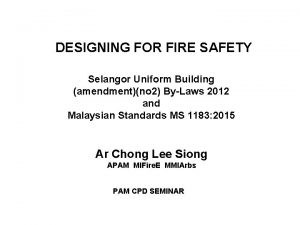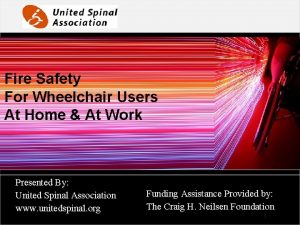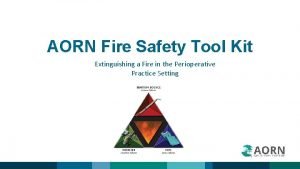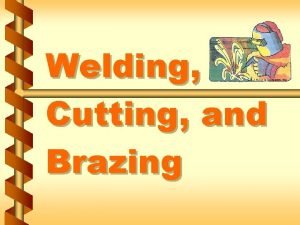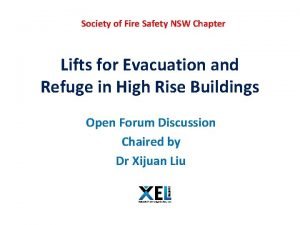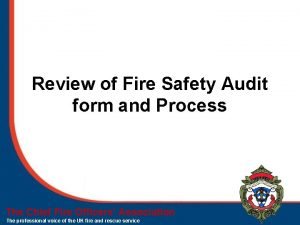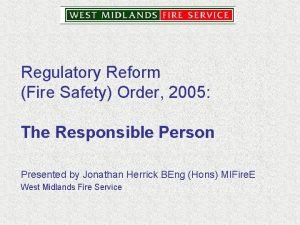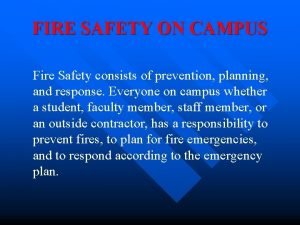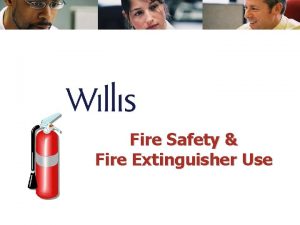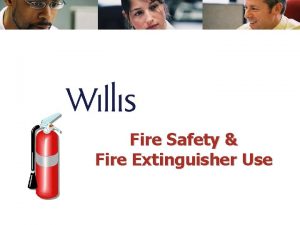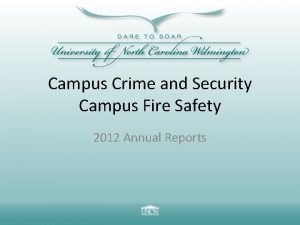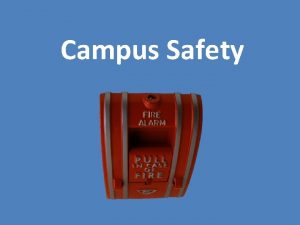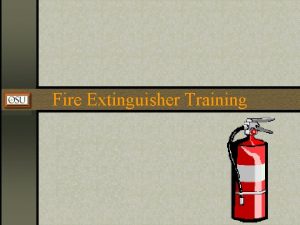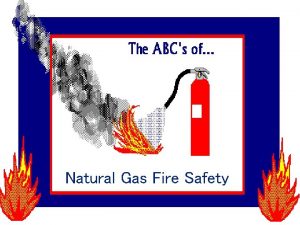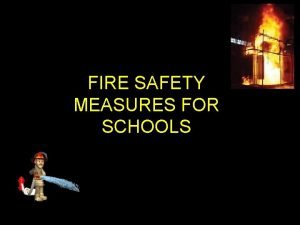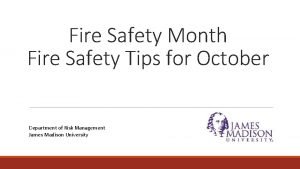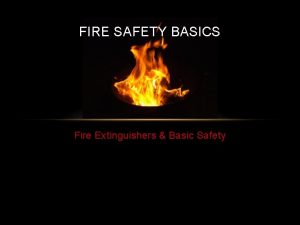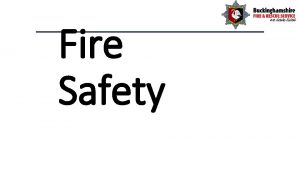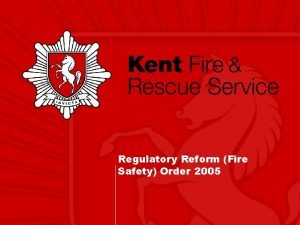FIRE SAFETY ON CAMPUS Fire Safety consists of































- Slides: 31

FIRE SAFETY ON CAMPUS Fire Safety consists of prevention, planning, and response. Everyone on campus whether a student, faculty member, staff member, or an outside contractor, has a responsibility to prevent fires, to plan for fire emergencies, and to respond according to the emergency plan.

HOW YOU CAN PREVENT CAMPUS FIRE HAZARDS n n n ELECTRICAL HAZARDS APPLIANCES COMBUSTIBLE STORAGE HOLIDAY DECORATIONS OPEN FLAMES n n FLAMMABLE LIQUIDS OBSTACLES SMOKING COOKING

ELECTRICAL HAZARDS Use of electrical "octopuses" can result in overloaded circuits and fire. Replace damaged wires and match appliance power requirements to the circuit power. A general "rule of thumb" formula is : appliance power (watts) / 220 volts = the approximate power (amps) being used. Most electrical circuits only supply 15 or 20 amps for all the outlets on that circuit. Extension cords should not be used as a substitute for permanent wiring.

APPLIANCES Use only authorized devices. Hotplates, percolators, irons, halogen lamps, space heaters, etc. , should not be left unattended and are prohibited in some places. They should be unplugged after use and not stored until they are cool enough to touch. Keep heaters away from curtains and furniture. Match the size of an extension cord to the appliance power cord to prevent cord overheating.

COMBUSTIBLE STORAGE Combustible material should not be stored in corridors, stairwells, or mechanical rooms.

HOLIDAY DECORATIONS Open flames are prohibited. Cut natural trees must be approved by FD. Decorations must be removed before leaving for the holiday break.

OPEN FLAMES Candles, Bunsen burners, sternos, etc. , should never be left unattended. Extinguish all open flames, even if left for a very short time. Most open flames require a permit. Contact the Security and Safety Department concerning the use of candles, and for permits for barbecue pits, bonfires, and welding/cutting processes.

FLAMMABLE LIQUIDS Gasoline, paints, glue, etc. , should not be stored in residential buildings. Flammable liquid storage in labs, shops, classrooms and office space, is limited to specific quantities and containers. Contact FD for specifics.

OBSTACLES Storage of bicycles, chairs, desks, and other items is prohibited in all exit ways. This includes securing bicycles to hand railings on ramps or stairs that are a part of the path of access/egress to buildings.

SMOKING Smoking is not allowed in most buildings on the AUBG campus Skaptopara-1, 2, 3, BAC, MB and ABF. Noncombustible ashtrays should be used in areas where smoking is allowed. Ashes, matches, and cigarette ends should be cold before being dumped.

COOKING Cooking should be done only in approved areas of kitchens, using only authorized devices. Grease should be cleaned from appliances as soon as possible.

HOW YOU CAN PLAN FOR A FIRE EMERGENCY GENERAL EVACUATION PROCEDURE n. Participate in fire drills and take them seriously.

HOW YOU CAN PLAN FOR A FIRE EMERGENCY. GENERAL EVACUATION PROCEDURE n. Be familiar with the location of at least two exits other than an elevator n. Elevators should not be used as an exit in a fire emergency

GENERAL EVACUATION PROCEDURE Know the location and operation of the fire alarm system

GENERAL EVACUATION PROCEDURE Remember 112 and keep the University guards emergency number (073 888 -100) posted

GENERAL EVACUATION PROCEDURE Learn how to use fire extinguishers, how to select the right type, and typical locations

GENERAL EVACUATION PROCEDURE Advise personnel to begin evacuating at the first sign of smoke or a fire alarm. Know the location outside the building where members of your department or class will meet upon exiting

GENERAL EVACUATION PROCEDURE Assign one person and a backup to assist with evacuating each disabled individual

HOW YOU SHOULD RESPOND DURING A FIRE EMERGENCY. SOUND THE ALARM n. If you discover or suspect a fire, sound the building fire alarm n. Dial 112 or notify the AUEOC at extension 073 888 -100

HOW YOU SHOULD RESPOND DURING A FIRE EMERGENCY EXTINGUISH THE FIRE Only use a fire extinguisher if the fire is very small and you know how to do so safely. Spend no more than 30 seconds making this effort.

HOW YOU SHOULD RESPOND DURING A FIRE EMERGENCY CONFINE THE FIRE n. Close as many doors and windows as possible as you leave. This helps to confine the fire.

EXIT VIA THE NEAREST STAIRWAY OR EXIT n n n Try to rescue others only if you can do so safely. Take your personal belongings and exit the building. Do not use an elevator as an exit. Move away from the building and don't interfere with the fire department's efforts. Do not go back into the building until allowed back in by AUEOC.

MEET AT PREDESIGNATED SITE Congregate at the pre-designated location outside the building so that a head count of the group may be taken.

ASSIST DISABLED PERSONNEL n n n If the fire is not on the same floor, close all doors and wait for assistance. Have a second person report your location to AUEOC or the Fire department. Hearing or visually impaired persons should be notified of the alarm and assisted, if necessary, to a safe escape route. If necessary, disabled persons may be assisted to the stairwell landings to await emergency personnel. All doors to the stairwell must be closed in order to reduce the buildup of smoke.

ADDITIONAL SKILLS TO HELP YOU SURVIVE A BUILDING FIRE FEEL DOORS BEFORE OPENING n CRAWL IF THERE'S SMOKE n SIGNAL FOR HELP n IF YOU ARE ON FIRE n

FEEL DOORS BEFORE OPENING Feel the door before opening it. If it's hot leave it closed and seal cracks and vents to keep the smoke out. If it is cool, brace against the door and open it slightly. If there is heat or heavy smoke, close the door and stay in the room.

CRAWL IF THERE'S SMOKE If you get caught in smoke, get down and crawl. Cleaner, cooler air will be nearer the floor.

SIGNAL FOR HELP Hang an object out the window to attract the fire department's attention. If there is a phone in the room, call the fire department and report that you are trapped. Be sure to give your room and location.

IF YOU ARE ON FIRE n. If your clothes catch on fire, stop, drop and roll, wherever you are. n. Rolling smothers the fire. n. Use cool tap water (immediately) on burns. n. Don't use ointments. n. If skin is blistered, dead white, brown, or charred, seek medical attention.

EMERGENCY NUMBERS /AUEOC-American University Emergency Operations Centers/ AUEOC Guards 073 888 Emergency Phone Number-112 100/112, 543, 110, 512.

 Uttar pradesh fire prevention & fire safety rules, 2005
Uttar pradesh fire prevention & fire safety rules, 2005 Race acronym
Race acronym A safety programme consists of how many e's
A safety programme consists of how many e's Skidmore campus safety
Skidmore campus safety Ohio training campus
Ohio training campus Plu campus safety
Plu campus safety Reichstag fire who was the fire starter
Reichstag fire who was the fire starter Fire damper access
Fire damper access A-e rwi
A-e rwi Race fire
Race fire 14:3 observing fire safety
14:3 observing fire safety Home fire safety patrol
Home fire safety patrol European fire safety community
European fire safety community Military fire safety
Military fire safety Race fire safety
Race fire safety Ceu catch a fire
Ceu catch a fire Fire safety objectives
Fire safety objectives Fire safety training ppt
Fire safety training ppt Alliance fire & safety
Alliance fire & safety Esu pencil
Esu pencil Regulatory reform fire safety order 2005
Regulatory reform fire safety order 2005 Paul nelis fire safety
Paul nelis fire safety Culinary crossword 2.1 fire safety answers
Culinary crossword 2.1 fire safety answers Purpose group ubbl
Purpose group ubbl Students to wring more from
Students to wring more from Fire safety for wheelchair users
Fire safety for wheelchair users Chapter 14 promotion of safety
Chapter 14 promotion of safety Aorn fire safety tool kit
Aorn fire safety tool kit Welding fire safety
Welding fire safety Mfb fire warden training
Mfb fire warden training Fire safety audit form
Fire safety audit form Regulatory reform fire safety order 2005 summary
Regulatory reform fire safety order 2005 summary

